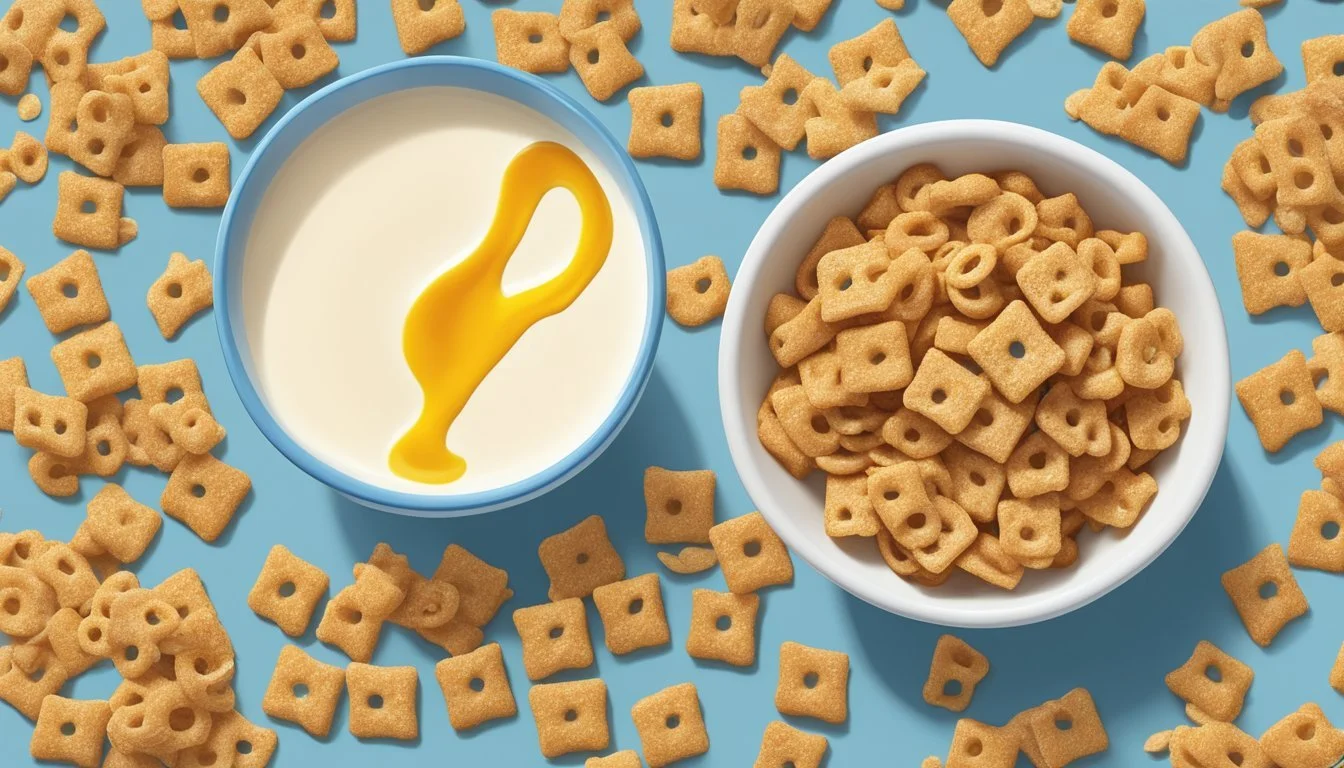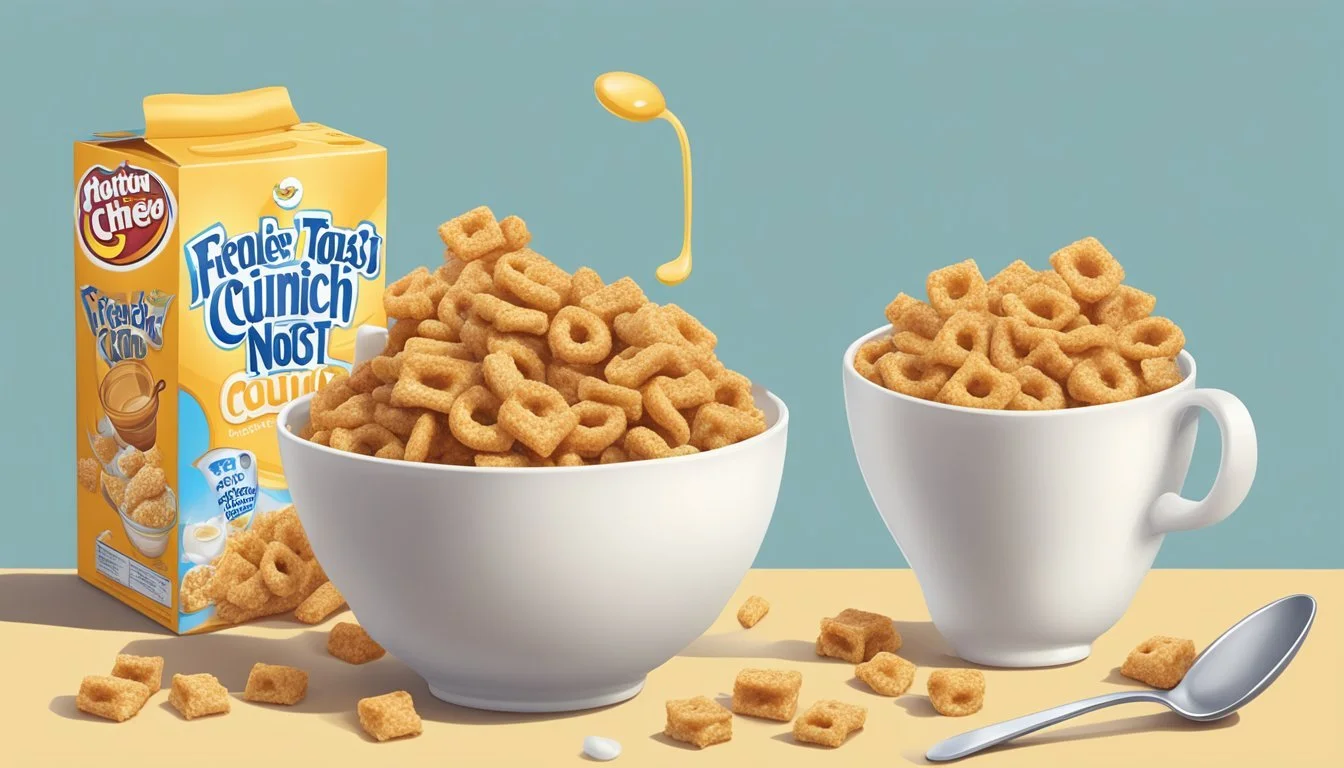French Toast Crunch vs Honey Nut Cheerios
Breakfast Cereal Showdown
This Article is Part of Our Breakfast Cereal Guide with Details on French Toast Crunch Nutrition and Honey Nut Cheerios Nutrition
When deciding between French Toast Crunch and Honey Nut Cheerios, it's important to consider both nutritional content and flavor preferences. Honey Nut Cheerios is slightly lower in calories and fat per serving, making it a healthier option for those who are calorie-conscious. For those looking for a balance between taste and nutrition, Honey Nut Cheerios offers the right mix of sweetness and health benefits.
In contrast, French Toast Crunch is a favorite for its unique cinnamon and maple flavor that mimics the taste of French toast. Though slightly higher in calories and sugar, it provides a nostalgic and flavorful breakfast experience. For some, this added flavor may justify the higher caloric content.
Both cereals cater to different taste preferences and nutritional needs. While Honey Nut Cheerios is a better choice for a more balanced diet, French Toast Crunch excels in providing an indulgent and flavorful breakfast experience.
Historical Background
French Toast Crunch and Honey Nut Cheerios each have unique histories that illustrate their evolution in the cereal market.
Origins of French Toast Crunch
French Toast Crunch, introduced by General Mills in 1995, aimed to capture the taste of French toast in a bite-sized cereal format. Targeted at children and families, it featured pieces shaped like mini slices of French toast and was known for its strong cinnamon and maple syrup flavor.
Initial reception was favorable, attracting attention for its nostalgic taste and unique design. It became a staple in the 1990s breakfast cereal market. However, it was discontinued in 2006 in the U.S. due to slowing sales but maintained a loyal fan base. Due to popular demand, it was reintroduced in 2014 with its original recipe and design, bringing back nostalgic joy to its dedicated followers.
Development of Honey Nut Cheerios
Honey Nut Cheerios, also from General Mills, debuted in 1979 as a sweeter version of the classic Cheerios. Created by Yandel Gonzalez, this variation combined the wholesome oat base of Cheerios with honey and almond flavoring.
Initially, the product included real nuts until the recipe changed in 2006 to accommodate allergy concerns. Accompanied by the iconic mascot BuzzBee, Honey Nut Cheerios quickly became a favorite in American households. Its combination of health benefits from oats and sweet flavor led it to become one of the best-selling breakfast cereals, surpassing even the original Cheerios in popularity.
Product Profiles
This section compares French Toast Crunch and Honey Nut Cheerios by examining their distinct characteristics and features. Each cereal has unique aspects regarding nutritional content, taste, and ingredients.
French Toast Crunch Characteristics
French Toast Crunch replicates the flavor of cinnamon and maple syrup-coated toast. The cereal features small, crispy pieces reminiscent of miniature slices of French toast.
Each serving of French Toast Crunch typically contains:
Calories: Approximately 120 per serving.
Sugar: About 9 grams.
Protein: 1 gram.
Fat: 3 grams, with minimal saturated fats.
Fiber: Generally low, around 1 gram.
Iron: Provides around 10% of the daily recommended value.
Calcium: Added minerals provide around 10% of daily needs.
The use of whole grains is limited, and the cereal primarily uses refined grains. The flavor profile is heavily influenced by the added cinnamon and sugar coating, making it a popular choice for those who enjoy a sweet, dessert-like breakfast option.
Honey Nut Cheerios Features
Honey Nut Cheerios combines the subtle sweetness of honey with a nutty flavor. It is shaped like small rings and offers a crunchier texture compared to other cereals.
Each serving of Honey Nut Cheerios generally includes:
Calories: Around 140 per serving.
Sugar: Approximately 12 grams.
Protein: 2 grams.
Fat: 1.5 grams, with very low saturated fats.
Fiber: 2 grams, supporting digestive health.
Iron: Contributes about 20% of the daily recommended value.
Calcium: Supplies around 10% of daily needs.
Whole Grains: Made primarily from whole grain oats.
Honey Nut Cheerios are known for their heart-healthy properties due to the inclusion of whole grains and their lower fat content. The addition of nuts and honey not only adds flavor but also provides essential nutrients, making it a balanced choice for a healthy breakfast.
Nutritional Comparison
French Toast Crunch and Honey Nut Cheerios both offer unique nutritional profiles that cater to different dietary needs and preferences. This section examines their sugar content, fiber, protein, vitamins, and minerals to help you make an informed decision.
Sugar Content Analysis
French Toast Crunch and Honey Nut Cheerios have varying sugar levels. French Toast Crunch contains approximately 10 grams of sugar per serving.
Honey Nut Cheerios, on the other hand, has a higher sugar content with about 12 grams per serving. Sugar content is crucial for those monitoring their sugar intake, especially children and individuals with diabetes.
Excess sugar can contribute to health issues, making Honey Nut Cheerios less ideal for those needing lower sugar diets.
Fiber and Protein Evaluation
Fiber and protein are essential for digestion and muscle repair. French Toast Crunch provides about 1 gram of fiber and 1 gram of protein per serving.
Honey Nut Cheerios offers slightly more fiber and protein, with 2 grams of fiber and 3 grams of protein per serving. This makes Honey Nut Cheerios a better option for satiety and digestive health.
Utilizing cereals with higher fiber content can aid in maintaining a healthy digestive system. Extra protein supports muscle maintenance, especially in active individuals.
Vitamins and Minerals Consideration
Both cereals are fortified with essential vitamins and minerals. French Toast Crunch includes iron, calcium, vitamin C, and vitamin B12, although in varying amounts.
Honey Nut Cheerios is also enriched with iron and calcium, but it provides additional vitamins such as vitamin D and vitamin B12. The presence of vitamin D in Honey Nut Cheerios can benefit bone health.
French Toast Crunch, however, also caters to some nutritional needs with its own set of fortified nutrients. Iron is crucial for preventing anemia, while calcium supports bone strength.
Health Considerations
When comparing French Toast Crunch and Honey Nut Cheerios, it's essential to understand their impact on blood sugar and their implications for heart disease. These factors play significant roles in evaluating the overall healthiness of each cereal.
Addressing the Impact on Blood Sugar
French Toast Crunch contains high levels of added sugars, which can cause rapid spikes in blood sugar levels. These spikes are particularly concerning for individuals with diabetes or those at risk. The high sugar content may lead to a quick energy burst followed by a crash, making it less suitable for sustained energy.
Honey Nut Cheerios, although also containing added sugars, typically have a lower glycemic index compared to French Toast Crunch. This means it raises blood sugar more slowly, making it a better option for blood sugar management.
Including honey as a sweetener helps provide a slow release of glucose into the bloodstream. Health experts like the American Diabetes Association suggest choosing cereals with low to moderate glycemic indices to manage diabetes effectively.
Heart Disease and Cereal Consumption
Fiber is crucial for heart health, and Honey Nut Cheerios offer more fiber than French Toast Crunch. Higher fiber intake helps lower cholesterol levels, reducing the risk of heart disease. The American Heart Association recommends eating cereals high in fiber to improve cardiovascular health.
French Toast Crunch, with its low fiber content, does not significantly contribute to heart health. While both cereals are fortified with vitamins and minerals, Cheerios’ higher fiber content makes it a more heart-friendly choice.
Consuming whole grains and fiber-rich foods is advantageous because it helps maintain healthy cholesterol levels and supports overall heart health. Therefore, Honey Nut Cheerios are preferable for individuals focusing on heart disease prevention.
Consumer Preferences
Consumers generally choose between French Toast Crunch and Honey Nut Cheerios based on their flavor preferences, health considerations, and brand loyalty. Understanding these factors can reveal how each cereal appeals to different demographics.
Market Positioning and Popularity
French Toast Crunch appeals to consumers who prefer sweet cereals with a distinctive maple flavor. This nostalgic cereal often attracts those who enjoyed it during childhood and continues to gain traction due to its unique taste and crunchy texture.
Honey Nut Cheerios, a staple in many households, is often marketed as a healthier option. It carries a brand reputation for being heart-healthy, partly because it contains whole grains and lower sugar content compared to many sweet cereals.
Both cereals maintain strong brand loyalty, but Honey Nut Cheerios usually leads in preference surveys focused on health-conscious consumers.
Trends in Consumer Choices
Recent surveys indicate a growing interest in organic and health-oriented foods. Despite French Toast Crunch's enduring popularity, many consumers are shifting towards healthier options. Honey Nut Cheerios benefits from this trend due to its positioning as a wholesome breakfast choice.
French Toast Crunch appeals strongly to those who prioritize flavor and nostalgia. On the other hand, Honey Nut Cheerios sees preference from those looking for a balance between taste and nutritional value.
The diverse appeal of both cereals highlights different consumer motivations, from indulgence to health and wellness.
Environmental and Ethical Impacts
French Toast Crunch and Honey Nut Cheerios have varying environmental footprints and adherence to ethical standards. This examination will dive into their production sustainability and the use of organic and non-GMO ingredients.
Production Sustainability
Production sustainability refers to the methods and practices used during the manufacture of these cereals. French Toast Crunch, produced by General Mills, utilizes modern production techniques to limit waste and reduce energy consumption. Reducing carbon emissions is a key focus, with facilities often adopting energy-efficient machines and recycling processes.
Honey Nut Cheerios also produced by General Mills follows stringent sustainability measures. They have implemented water conservation practices and encourage biodiversity around their agricultural sites. Investments in renewable energy sources, such as solar panels, aim to reduce the carbon footprint associated with cereal production.
Use of Organic and Non-GMO Ingredients
Non-GMO and organic ingredients are critical talking points for consumers. French Toast Crunch primarily uses conventional ingredients, and there is limited availability of organic or non-GMO versions. This may concern consumers who prioritize organic options for health or environmental reasons.
Honey Nut Cheerios offers more transparency in ingredient sourcing. They have made efforts to integrate more non-GMO ingredients into their offerings. Unfortunately, the overall organic content remains limited. The non-GMO Project verification is often seen on their packaging, indicating strides in meeting consumer demand for ethically sourced ingredients.
Environmental and ethical considerations influence consumer choices, and both cereals have unique approaches to meeting these expectations.
More on French Toast Crunch
Cinnamon Toast Crunch vs French Toast Crunch: Which is better?
French Toast Crunch vs Kellogg's Apple Jacks: Which is better?
French Toast Crunch vs Kellogg's Froot Loops: Which is better?
French Toast Crunch vs Post GrapevsNut Flakes: Which is better?
French Toast Crunch vs Post Raisin Bran Cereal: Which is better?
More on Honey Nut Cheerios
Cinnamon Toast Crunch vs Honey Nut Cheerios: Which is better?
Honey Nut Cheerios vs Kellogg's Apple Jacks: Which is better?
Honey Nut Cheerios vs Kellogg's Froot Loops: Which is better?
Honey Nut Cheerios vs Post GrapevsNut Flakes: Which is better?
Honey Nut Cheerios vs Post Raisin Bran Cereal: Which is better?





